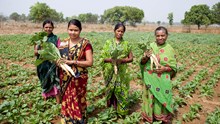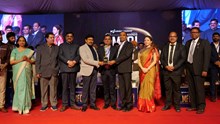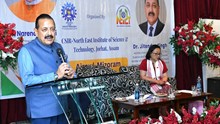
The ICAR Research Complex for Eastern Region (ICAR-RCER), Patna, inaugurated an innovative 'Multiple Use of Water' (MUW) Model at its Sabajpura Farm, aiming to promote efficient and sustainable water management to enhance agricultural productivity across eastern India. The model was formally inaugurated by Dr. S.K. Chaudhari, Deputy Director General (Natural Resource Management), ICAR, during a special ceremony held on January 04, 2024, at the farm.
Speaking at the event, Dr. Chaudhary commended the pioneering approach of the MUW model and emphasized the critical importance of efficient water utilization through multiple water-use strategies to address the growing challenges of climate change and resource management in agriculture. During inauguration of the program, an extension folder on MUW was released and a short video was shown on overview of MUW.
In this inaugural program, various esteemed directors such as Dr. Masood Ali (Former Director ,ICAR-IIPR), Dr. C.L. Acharya (Former Director, ICAR-IISS), Dr. J.S. Mishra (ICAR-DWR, Jabalpur), Dr. N.G. Patil (ICAR-NBBS LUP), Dr. Bikas Das (ICAR-NRC Litchi), Dr. A. Sarangi (ICAR-IIWM), Dr. Sunil Kumar (ICAR-IIFSR, Modipuram), Dr. Pradip Dey (ICAR-ATARI, Kolkata), Dr. B. P. Bhatt, PS, NRM Division, ICAR, New Delhi, Dr. R.K. Jat (BISA), Dr. S.P. Poonia (CIMMYT) etc. were present.
Addressing the gathering, Dr. Anup Das, Director of ICAR-RCER, Patna outlined the broader vision of the MUW model. He emphasized that advanced practices like mulching, agri-horti systems, composting, solar energy applications, and greenhouse gas reduction are integral to the model, ensuring long-term sustainability and efficient water resource management. Dr. Das also underscored the model’s potential to address growing climate and resource challenges in the agricultural sector by promoting resource optimization and resilience in farming systems.
During the inauguration, Dr. Ashutosh Upadhyaya, Head of the Division of Land and Water Management, provided an in-depth overview of the model. He highlighted its key components, including composite fish farming, duck rearing, mushroom production, and crop diversification through modified raised and sunken conservation beds and agro-aqua land configurations specifically designed for lowland areas. He further stressed that the MUW model integrates innovative water conservation practices, ensuring efficient resource management while enhancing agricultural productivity and resilience in a sustainable manner.
The development of this innovative model was the result of a collaborative effort by a team of scientists, including, Ashutosh Upadhyaya, Ajay Kumar, Akram Ahmed, Arti Kumari, Pawan Jeet, Surendra Ahirwal, Shivani, Tanmay Koley, M.K. Tripathi, Ved Prakash, Rachna Dubey, Abhishek Kumar and Abhishek Dubey, under the leadership of Dr. Anup Das. Their combined expertise and dedication played a pivotal role in designing and implementing the MUW model.
This was followed by a field visit, where Dr. Chaudhari saw the long-term experiments on the Cereal Systems Initiative for South Asia (CSISA) and rice fallow management, aimed at optimizing the use of natural resources.
The Multiple Use of Water (MUW) Model represents a significant step forward in sustainable agricultural intensification, offering a comprehensive framework for water-efficient farming systems that address climate resilience and resource conservation while enhancing livelihoods of farmers in lowland areas.
















